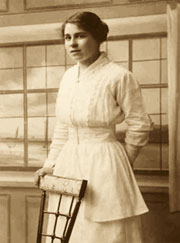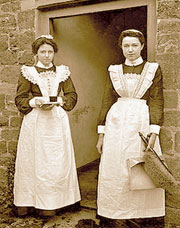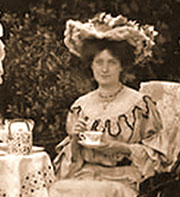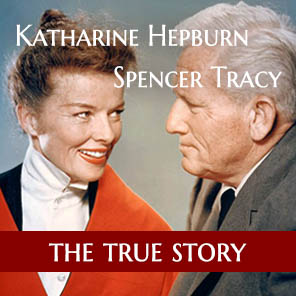Is Scotty Bowers, the famous Hollywood pimp telling the truth about Spencer Tracy and Katharine Hepburn? Here's a confirming story...
Laundering Table Linen
 REMOVAL OF STAINS
REMOVAL OF STAINS
Remove all stains as soon after they are made as possible. Wash out milk or meat stains with warm water. When the linen is stained by tea, chocolate, coffee, or fruit, stretch the portion of linen discolored over a bowl. Have ready a kettle of water at the boiling point; hold the kettle high, and let the water fall from it onto the stain, until it disappears. Most stains will yield to this treatment. Peach stains are the most difficult to remove. If the stain be small, wet it thoroughly, then burn a sulphur match under the wet spot. Cover wine stains with common salt, then pour boiling water through them as described above.
WASHING THE LINEN
Shave laundry soap very fine, pour boiling water over it, and set it on the back of the range to dissolve; then pour into a tub and add lukewarm water to make a suds; in this put the linen, the larger pieces at the bottom, to stand for several hours or over night. Wring the pieces from this water and put them into a tub of water of such temperature as can be well borne by the hand. Wash out and put into a boiler (upon the stove), half filled with cold water and to which soap shaved and dissolved in water has been added; let the linen remain over the fire until the water boils, then take it up and dispose in a tub of cold water; let stand a few moments, then rinse thoroughly, to remove all soap, then wring out and put into a tub of bluing water; wring out and put to dry in the open air. Use either liquid or ball bluing. To use the ball bluing, tie a ball loosely in a flannel bag. Move the ball back and forth in a dipper of lukewarm water until it is well blued, then turn into the tub of water. Add more bluing after a portion of the linen has been wrung from the water.
STARCHING TABLE LINEN
Linens of good body need no starch. Very thin, old linen tablecloths may be wrung outof very thin starch. Do not use more than one level tablespoonful of starch to two quarts of water. Dilute the dry starch with two or three tablespoonfuls of cold water, pour over the boiling water, and stir and cook about ten minutes ; then add half a teaspoonful of powdered borax, Strain the starch, if necessary; add a little bluing, if desired, and wring the linen as dry as possible.
FOLDING LINEN TO IRON
When the linen is dry enough to iron, fold the tablecloths in the middle, lengthwise, letting the corners come exactly together and the sides and ends meet at every point, then fold again, and finally roll up tightly, and finish by rolling in a dry cloth. Lay a napkin flat upon the table ; above this lay other napkins, one after another, spreading each out smoothly and stretching the hems. If not already so, all table linen should be made very damp. Sprinkle with clean water, using a clean brush kept for the purpose. Roll very tightly and protect from the air by rolling in a cloth. Let stand several hours or over night. In the latter case store the clothes basket, especially in hot weather, in a cool place.
WASHING LINEN WITH COLORED EMBROIDERY
Dissolve two level tablespoonfuls of powdered borax in a little hot water and add to a gallon of water. Take the pieces, one at a time, sop in the water, rinse up and down, and knead until clean; repeat this process in clear water, then roll in a dry cloth. Continue until all are washed. In this way the colors will not stain the linen. The dry cloth will take up the water quickly and the pieces need to be ironed in a very few moments.
IRONING
For good results in ironing a perfectly flat and firm ironing board is a first requisite. Have the board smoothly covered with soft material, above this have an outer covering of rather fine cotton cloth tightly drawn and fastened securely in place.
EMBROIDERED LINEN
To iron small pieces of embroidered linen use a heavy, moderately hot iron and press hard. Iron on the wrong side and always with the threads of the linen, pushing the iron from you.
DRAWN WORK
In washing, drawn work shrinks more than the plain linen around it, and great care needs to be taken to stretch the drawn work and make the piece of uniform size throughout. Lay the edge straight with the edge of the board and stretch the drawn work in both directions before beginning to iron. Iron on the wrong side, stretching gently while ironing. Dampen, stretch, and iron until the article is in perfect shape and absolutely dry.
LINEN WITH LACE EDGES
Iron the linen portion first, of pieces having lace edges, then iron the lace on the wrong side and without stretching the edge of the linen.
FOLDS IN TABLE LINEN
Linen used on sideboard and serving-table should be rolled on pasteboard cylinders made for this purpose. Folds are not admissible in any table linen, save napkins and the lengthwise fold through the centre of tablecloths. The pasteboard cylinders cost about fifteen cents.
FRINGED NAPKINS
In folding napkins with a fringed edge gently whip the edges to disentangle the fringe, and when ready to iron, repeat the snapping, then lay the napkin on the ironing board, and with a whisk broom brush out the fringe; then iron the centre, and when this is dry, the fringe; brush out again after ironing, and if needed, trim with a pair of scissors.
NAPKINS
Fold the selvage edges of the napkin together and stretch until perfectly straight. Unfold and spread out wrong side up on the table; with a heavy, hot iron press out the napkin, then fold the selvages together and press upon one side; turn and press upon the other side; fold again, and stretch, to have the central fold lie directly above the full length of the selvages; press on each side, then fold and press to make a square. Have monogram, if present, on the top when finished.
TABLECLOTHS
Many who iron small pieces until they are dry fail to do this in ironing a large piece, like tablecloth, hence, the lack of gloss upon the surface of the cloth. For convenience, a tablecloth is not ironed in a single thickness, and, in consequence, longer ironing is needed to dry it out.
Two persons are really needed to get a tablecloth in readiness to iron. Let each take an end of the cloth, and see that the hem on one side lies directly over the hem on the other side, with the selvages coming together, then stretch the cloth, gathering it a little in the hands at the ends, if needed. Make sure that the selvages are even, and the lengthwise fold will be even. Put a table back or beyond the ironing board. Spread one end of the cloth on the ironing board and dispose the rest on the table. Let the iron rest on the cloth (do not raise it from the cloth), and move it up and down with the warp; move it slowly and gently until the wrinkles are removed, making sure that the selvages and herns are exactly together; then press hard and more quickly; continue in the same way until the cloth is nearly ironed, then make the hems straight and even and iron from the hems towards the ironed portion, to remove any fulness that may have accumulated. Now turn the cloth and iron upon the other side until dry. Lay the paper roll on the end of the cloth next you; see that it is even, then roll a little, pressing the linen, with the iron, in front of the roll. Lift the cloth frequently to keep it straight. Many prefer a clean sheet, spread upon the floor under the ironing board, to the extra table behind the board. Use a heavy iron.




